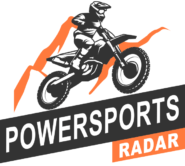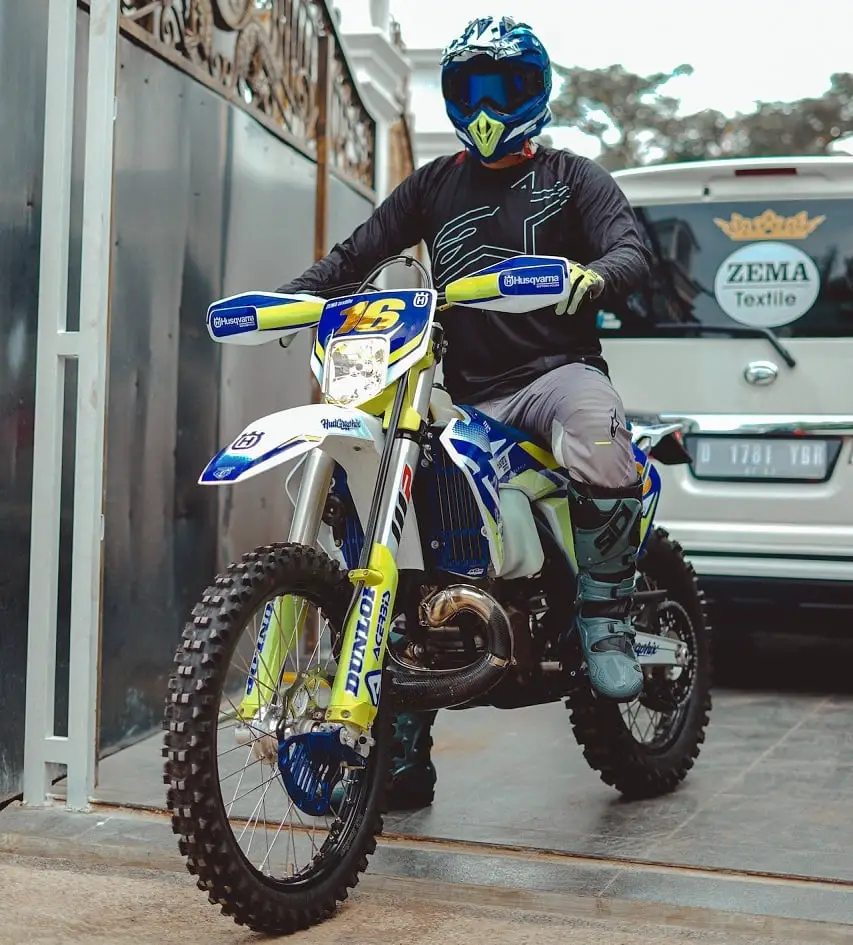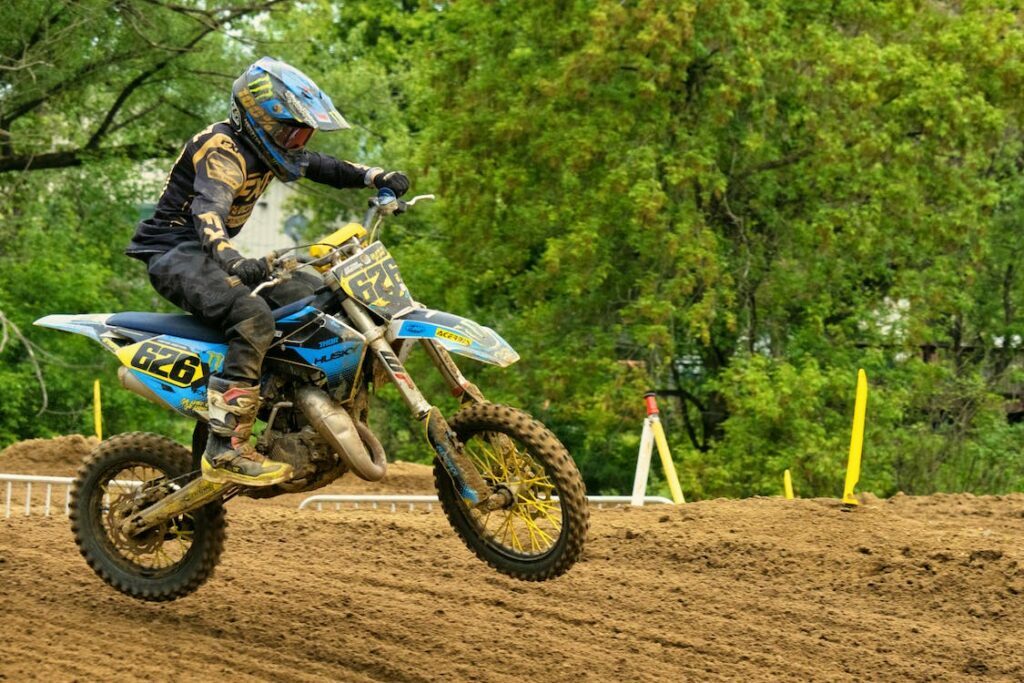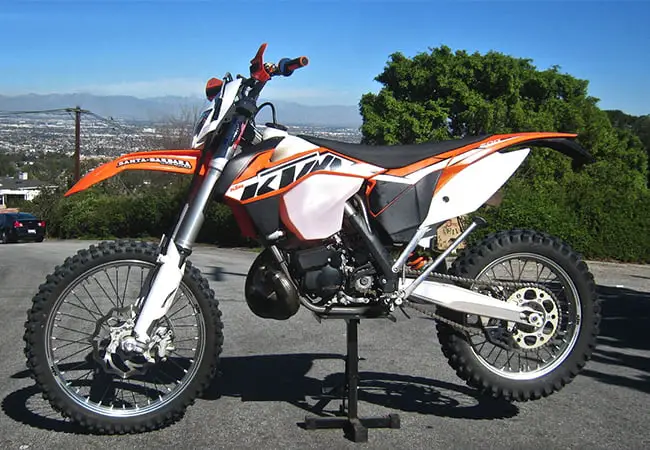Watching those jaw-dropping races and epic trail rides can ignite a burning desire to hit the dirt. But before you go full throttle, let’s talk about how to buy a dirt bike that’s perfect for you.
The key to finding the perfect dirt bike is smart decision-making, which starts with solid research. Your goal is to find a dirt bike that matches your skills, style, and budget.
In this post, I’ll guide you through a foolproof, step-by-step process to buy a dirt bike that suits your skills, riding style, and budget. So buckle up, and let’s start this dirt bike-buying journey!
Determine your budget
Setting a budget for your dirt bike purchase is a crucial step that may not sound exciting, but trust me – it’s essential for a smooth buying journey. Let’s find the proper budget for your dream dirt bike:
- Assess your finances – Consider your income, expenses, and financial obligations. It’s essential to balance your desires and your financial well-being.
- Research prices – Search for reliable sources like manufacturer websites, reputable dealers, and online marketplaces to gather accurate pricing information.
- Consider long-term goals – Are you riding for fun or going pro? You might need a larger budget for a high-performance bike if you have ambitious riding aspirations.
- Factor in additional costs – Remember to account for expenses beyond the bike, such as modifications, regular maintenance, dirt bike gear (helmet, boots, goggles, etc.), and insurance.
Research and choose a type
Now let’s dive into the exciting part: finding the perfect dirt bike! Here’s what to consider during your search:
- Riding style – Choose a bike that matches your preferred type of riding – whether it’s high-speed motocross or conquering diverse terrains with an enduro or trail bike.
- Size and fit – Make sure you can touch the ground comfortably and reach the handlebars and controls easily when on the bike for better handling and confidence.
- Engine size and power – Smaller engines like 125cc are suitable for beginners, while larger engines like 250cc or 450cc offer more power for experienced riders or racing.
- Maintenance and durability – Some bikes require less frequent maintenance, like the Yamaha YZ250, giving you more riding time and less time tinkering.
- Reviews and recommendations – Explore reviews, YouTube videos, and dirt bike forums to gather insights and advice from experienced riders.
Assess your skill level

As you embark on your dirt bike journey, knowing your skill level and finding the right bike for you is crucial. Take the time to reflect on these questions:
- What’s my riding experience?
- What type of riding do I prefer?
- How comfortable am I with off-road riding and challenging terrains?
- What are my strengths and weaknesses as a rider?
- How do I compare to riders with similar experience levels?
- How committed am I to learning and improving?
Determine your bike size
Finding the right size dirt bike is crucial for a comfortable and confident off-road adventure. Here’s how to determine the perfect fit:
- Comfortable feet placement – You should be able to touch the ground comfortably for stability and weight support
- Seat height – Your feet should rest flat on the ground when seated for balance and control.
- Handlebar reach – You must be able to get to the handlebars without strain.
- Smooth maneuvering – You can shift your weight and change directions smoothly without feeling strained or off-balanced.
Use BikeMatch for dirt bike recommendations
We have developed a free tool for you to help choose the perfect dirt bike. Check it out here: BikeMatch
Explore local regulations
Before looking for sellers or dealerships, familiarize yourself with local dirt bike regulations in your area. Research curfews, off-road trail permissions, and other laws so you can enjoy your off-road escapades without getting on the wrong side of the law.
While regulations may differ from state to state, here are some general guidelines to remember:
Noise regulations
Different regions have specific noise limits to manage noise pollution. For example, in Marseilles, Illinois, vehicles, including dirt bikes, exceeding the 55 dBA limit are prohibited in residential areas from 10 PM to 7 AM. They also require muffling devices on the bike’s exhaust to reduce noise.
Emission regulations
The Environmental Protection Agency (EPA) sets emission standards to minimize recreational vehicles’ environmental impact. When selecting your dirt bike, you can refer to the EPA’s exhaust emission standards for off-highway motorcycles.
Legal riding areas and trails
Check with local authorities, off-road clubs, or online resources to find suitable and legal dirt bike trails to enjoy your bike responsibly.
Licensing and registration
Some regions require dirt bike licenses and registrations. You may need to complete specific training courses, obtain an off-road vehicle (ORV) permit, or meet age and eligibility criteria.
Age restrictions
Different areas have specific age requirements for off-road vehicles. Ensure the dirt bike you choose suits the intended rider’s age and complies with legal requirements.
Mandatory safety equipment
Check local regulations to determine safety gear to wear when riding.
Decide between brand-new or used
Deciding between a brand-new or secondhand dirt bike can be a tough choice to make. But fear not! I’m here to help you weigh your options.

Consider these questions to make the right decision:
What’s your budget?
If money isn’t an issue, go for a brand-new bike. But if finances are tight, a secondhand bike is the smarter choice.
What’s your skill level and experience?
If you’re new to dirt biking and still honing your skills, a secondhand bike is more forgiving. Minor falls or scratches won’t sting as much, and you won’t feel guilty about a few battle scars.
How’s your mechanical know-how?
A secondhand bike will do the job if you’re handy with maintenance and repairs or willing to learn.
What’s the availability like in your area?
Are brand-new bikes more abundant, or are there more options on the secondhand market?
Is warranty a priority?
If you’re a beginner or value warranty and assistance, investing in a brand-new dirt bike might be worth the extra money.
Search for sellers
Alright, time to find that perfect dirt bike for your off-road adventures! Whether you’re looking for a secondhand gem or a shiny new machine, I’ve got you covered with the best places to find your dream dirt bike.
For secondhand dirt bikes
- Online marketplaces like Craigslist, eBay, and Facebook Marketplace are treasure troves of used bikes. Use search filters, connect with sellers, and inspect the bikes in person before buying.
- Dirt bike forums are where fellow enthusiasts gather. Browse listings or post your request. You’ll likely find what you’re looking for or get valuable leads.
- Local dealerships and shops sometimes have used bikes available. The advantage is that these bikes have undergone inspection and reconditioning before being sold.
- Tap into the local riding community. Ask riders if they or someone they know sell dirt bikes.
- Don’t forget about dirt bike auctions! Do your research, stick to your budget, and bid wisely to snag a great deal.
- Your local repair shop might have bulletin boards or listings of bikes for sale. Drop by and check out what’s available.
- Off-road rental businesses occasionally sell their current bikes. Inquire if they want to sell their current bikes to refresh their fleet.
For brand-new dirt bikes
- Authorized dealerships of your preferred manufacturer are the go-to places. They can offer expert advice, customization options, and access to the latest models and promotions.
Tip: Timing is everything! The off-season, especially December and February, is the best time to snag great deals on brand-new dirt bikes.
- Check the manufacturer’s website for comprehensive details, specifications, and pricing for your preferred model. They often have a “Find a Dealer” feature to help you locate the nearest dealership. You can also request a quote or schedule a test ride online.
- Attend dirt bike shows and expos to see the latest model releases from your preferred brand! It’s also an excellent opportunity to compare models, chat with experts, and benefit from show-exclusive deals.
- Dirt bike magazines and publications are the best places to find experts’ reviews, buyer guides, and ads from dirt bike manufacturers and dealerships.
- Social media marketplace groups also have listings from individuals or dealerships selling brand-new bikes. Be cautious when dealing with private sellers and ensure their legitimacy before making any transactions.
Finding a legit dirt bike seller can be tricky, especially if you’re looking online. Let me share some personal tips to help you find a legit seller, whether online or offline:
- Do thorough research – Explore all the places I mentioned earlier and make a list of sellers you like. Leave no stone unturned!
- Do a background check – Investigate a potential seller’s reputation and credibility. Check online reviews and ratings, and watch out for red flags or complaints from previous buyers.
- Search for untapped areas – To find sellers willing to offer lower prices, search for locations with less dirt bike scene, such as your neighboring regions.
- Enlist a mechanic’s help – Consult an experienced mechanic to verify the seller’s claims, especially when dealing with online sellers. They can spot suspicious claims or bikes that seem too good to be true.
- Don’t underestimate referrals – Word-of-mouth recommendations are gold in our dirt bike community. Ask fellow riders, friends, and local riding groups for trustworthy seller suggestions or if they know anyone selling a bike.
- Post it on social media or bring it up in conversations – Someone within your network might be considering selling their bike but haven’t advertised it yet.
Inspect and test ride
Buckle up because we’re about to reach the most crucial stage of your dirt bike-buying journey: inspection and test ride! This is where you determine if it’s a deal or a dud.
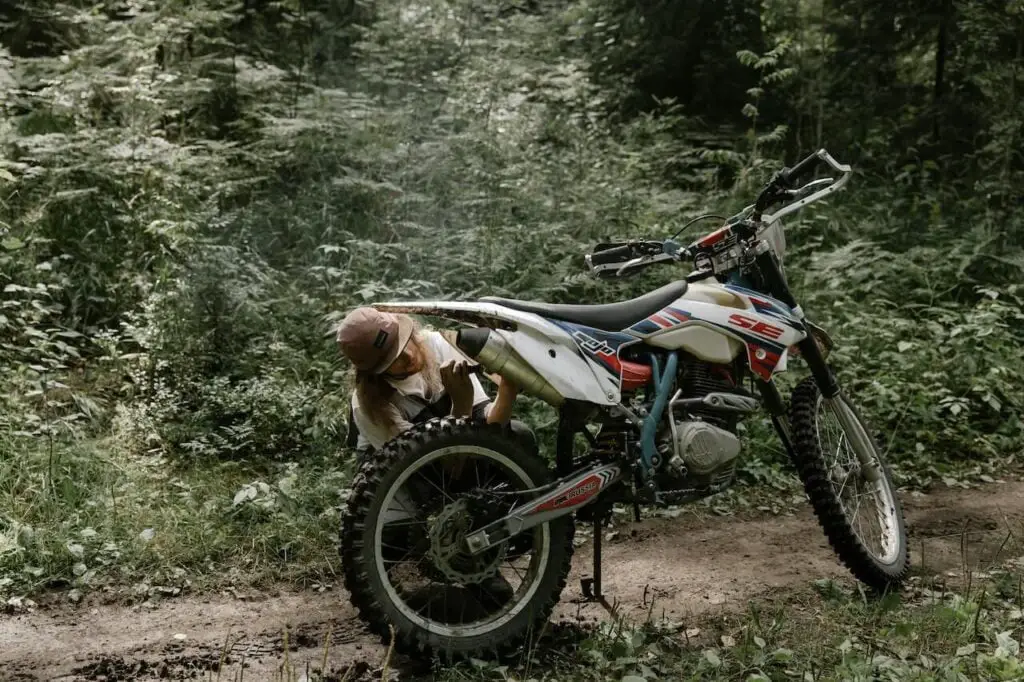
To ensure you don’t miss any crucial details, here are the essential parts you should inspect:
- The bike’s frame
- Tires
- Suspension
- Brakes, chains, and sprockets
- Fluid leaks
- Clutch and throttle response
- Transmission
- Air filter
I have a separate in-depth guide on what to look for when buying a used dirt bike. Feel free to check it out!
Negotiate
Most riders dread this part, and I can’t blame them. It’s nerve-wracking making offers left and right. But don’t panic – I got your back. Let’s dive into the steps on how to negotiate for your dream bike:
- Do your homework. Before you enter the negotiation battlefield, arm yourself with knowledge of local market prices for similar dirt bikes. This way, you’ll know what’s a fair offer.
- Bring backup. If you know someone who’s a dirt bike expert or has tons of experience, bring them along during the negotiation. They can help you assess the bike’s value and give you an edge.
- Start smart. Begin with a reasonable price lower than your budget. A price too low might offend the seller. Be ready for counteroffers and work your way up gradually.
- Confidence is key. Stay calm, assertive, and confident during the negotiation. Show the seller you mean business and know your stuff.
- Stick to your budget. Don’t let excitement cause you to overspend. Stick to your budget since you have to consider other costs like gear and repairs.
- Flexible payments. If the seller doesn’t budge, propose a down payment followed by installments. It can make the offer more appealing to both parties.
- Be open to compromise. If the price is still a roadblock, offer additional accessories or services as a compromise.
- Timing is everything. Market knowledge and timing are crucial when negotiating a new bike. Research when manufacturers or dealerships offer deals and promotions so you can buy a brand-new bike at a lower price.
Bonus tips for sealing the deal:
- If negotiations hit a dead end, step back and explore other options. This can also create a sense of urgency for the seller to reconsider.
- Make a connection. Show genuine enthusiasm, engage in conversations about your shared passion, and build rapport with the seller. People are more willing to negotiate with someone they like.
- Seek motivated sellers. Look for sellers motivated to sell due to moving, upgrading, or financial constraints. They’re more likely to entertain reasonable offers.
Get proper gear
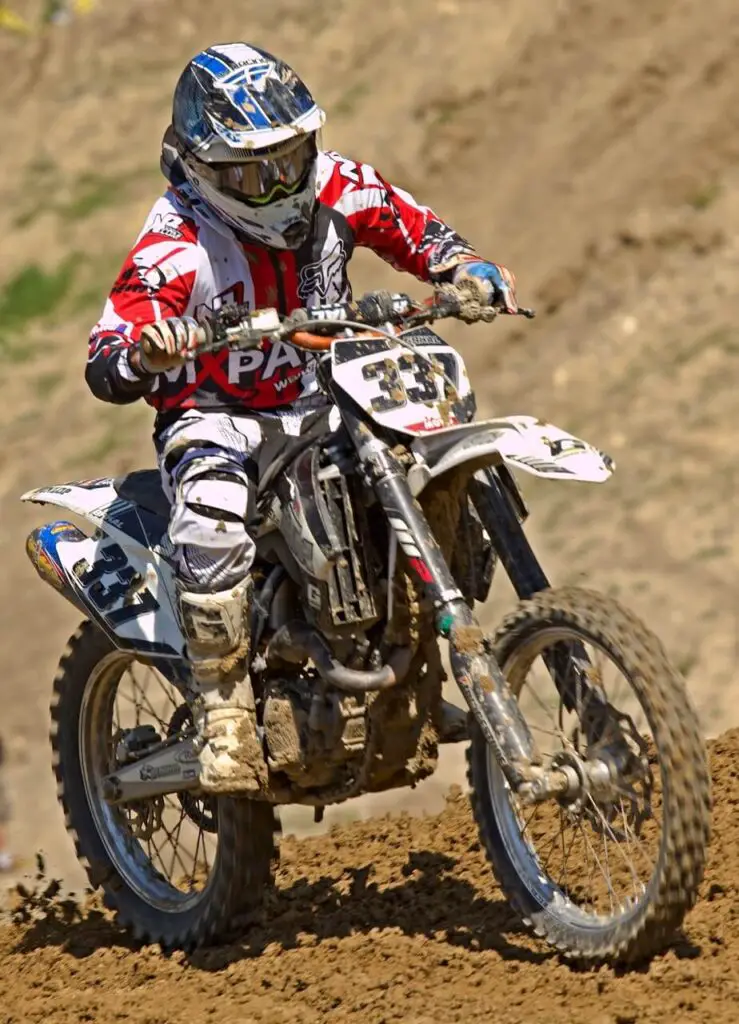
Congrats on snagging your new dirt bike! Time to gear up and hit those trails. Don’t forget these dirt bike gear essentials for a safe ride with maximum confidence:
- Helmet
- Goggles
- Boots
- Gloves
- Chest Protector/Body Armor
- Knee and elbow guards
- Tool kit
Add extras like a hydration pack for comfort if you’re up for it. But if you’re still starting, the must-haves above will keep you safe and comfy off-road.
Arrange transportation
Time to bring your new baby home! Here are the most convenient ways to transport your dirt bike safely to your garage:
- Pickup truck or trailer – Load your bike onto a trailer, secure it with a wheel-chock and tie-down straps, and head to your garage or the trails for action.
- Dirt bike carrier – Attach a specialized rack to your vehicle’s hitch receiver for a sturdy platform. These carriers often have ramps for effortless loading.
- Van or enclosed vehicle – Create enough space by removing seats or obstacles from your van or enclosed vehicle. Secure the bike using straps or tie-downs.
- Professional Transport Service – For hassle-free long-distance transport, hire a professional service specializing in motorcycle shipping.
Conclusion
Buying a dirt bike can be a thrilling and rewarding experience if you approach it with the right mindset. You should follow the steps we’ve explored in this post. This is the best and most crucial investment in your off-road journey, and with the right bike by your side, the possibilities are endless.
When buying a dirt bike, always be honest with yourself. Be honest about your desired features, riding skills and preferences, and budget. Do this, and you’ll be well on your way to bringing home the dirt bike that excites you to hit the trails daily.
With each step we’ve covered, from research and negotiation to proper gear and transportation, you’re closer to bringing home your new off-road best friend. Soon enough, you’ll be out there, tearing up the dirt and experiencing the exhilaration only a dirt bike can provide!
